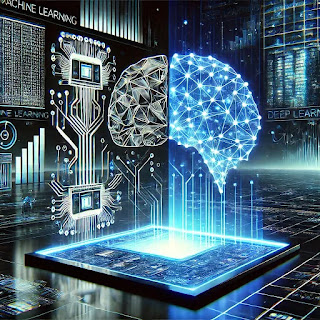Machine Learning vs. Deep Learning: What’s the Difference?🤖
🚀 Introduction
Artificial Intelligence (AI) has transformed the tech world, and at its core are two powerful technologies: Machine Learning (ML) and Deep Learning (DL). While these terms are often used interchangeably, they have distinct differences that impact how they shape industries. Let’s explore how they work and their real-world applications! 🔍
🤔 What is Machine Learning?
Machine Learning (ML) is a subset of AI that enables computers to learn from data and improve over time without being explicitly programmed. ML uses algorithms to detect patterns, make decisions, and predict outcomes based on historical data.
🛠️ Key Features of Machine Learning:
- 📊 Supervised Learning – Learns from labeled data to predict outcomes (e.g., spam detection, image recognition).
- 📈 Unsupervised Learning – Finds hidden patterns in unlabeled data (e.g., customer segmentation, anomaly detection).
- 🎲 Reinforcement Learning – Uses rewards/punishments to train models (e.g., robotics, gaming AI).
Example: Netflix’s recommendation engine learns from user preferences to suggest personalized content. 🎥
🤯 What is Deep Learning?
Deep Learning (DL) is a subset of ML that mimics the human brain using artificial neural networks. It processes vast amounts of data through multiple layers, making it incredibly powerful for tasks like image recognition, speech processing, and self-driving cars.
🛠️ Key Features of Deep Learning:
- 🧠 Neural Networks – Multiple layers (deep neural networks) process complex data.
- 🌊 Data-Driven Learning – Requires large datasets and computational power.
- 📢 Feature Engineering – Automatically extracts patterns without manual intervention.
Example: Self-driving cars use deep learning to detect traffic signals, pedestrians, and obstacles in real-time. 🚗💨
⚖️ Machine Learning vs. Deep Learning: Key Differences
| Feature | Machine Learning (ML) | Deep Learning (DL) |
|---|---|---|
| Data Requirement | Works with small to medium datasets | Requires large datasets |
| Feature Extraction | Requires manual feature engineering | Learns features automatically |
| Computational Power | Less intensive, runs on CPUs | Highly intensive, needs GPUs |
| Use Cases | Fraud detection, recommendation systems | Image recognition, natural language processing |
🌍 Real-World Applications
- 🏦 Finance: ML predicts stock trends, while DL detects fraud using complex neural networks.
- 🏥 Healthcare: ML diagnoses diseases using past data, while DL interprets medical images like MRIs.
- 🎮 Gaming: ML powers game AI, while DL enables realistic character animations.
- 🛒 E-Commerce: ML suggests products, while DL personalizes customer interactions.
🔮 Future of ML & DL
Both Machine Learning and Deep Learning will continue to evolve. As computing power increases, DL will become more accessible, revolutionizing industries further. The combination of ML and DL will drive the next wave of AI-driven automation. 🚀
💬 What’s Your Take?
👉 Which technology do you think will dominate the future—Machine Learning or Deep Learning? Let us know in the comments! 🧠💡

Comments
Post a Comment